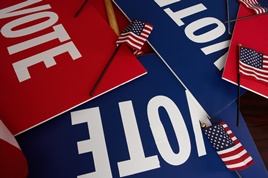 Indiana Business for Responsive Government (IBRG), the non-partisan political action program of the Indiana Chamber of Commerce, fought through one of the most challenging primary election cycles in its history with 12 of 14 IBRG-endorsed candidates winning their respective primary elections (including Eric Bassler’s big victory over 20-year incumbent State Sen. John Waterman).
Indiana Business for Responsive Government (IBRG), the non-partisan political action program of the Indiana Chamber of Commerce, fought through one of the most challenging primary election cycles in its history with 12 of 14 IBRG-endorsed candidates winning their respective primary elections (including Eric Bassler’s big victory over 20-year incumbent State Sen. John Waterman).
Today, Hoosier voters believe their state government is on the “right track” by margins probably not seen in a generation of polling in the state, while holding nearly mirror opposite views of the federal government. Hoosiers have confidence in where our growing economy is headed and strongly support a variety of reforms that are helping Indiana lead the nation in economic growth.
However, large blocks of Hoosiers also detest the federal government, distrust both political parties, and want someone or something to lash out at. With Republicans in charge of both houses of the General Assembly by strong quorum-proof majorities, if you’re looking for some political payback in Indiana, the Republicans are the ones calling the shots.
In the 2014 primary elections, no Democrat incumbent legislator faced a primary election challenger. There were only two Democratic primaries in the state for “open” (i.e. no incumbent running) legislative seats, both in Lake County. The 2014 primary elections were about the Republicans. It’s important to note that the 2012 primary elections were the first held after redistricting. Twenty-two districts in 2012 did not have an incumbent running, compared to only eight this primary election. If you look at the House, the difference is even more stark – 20 open seats in 2012 and only three in 2014. So, the 2014 primaries had a lot more to do with incumbents.
In 2012, the labor unions were still hopping-mad over right-to-work and running a number of candidates against GOP incumbents and open seat races. They all failed. While the ISTA teachers union and “Lunch Pail Republicans” were back this year, a new and formidable primary challenge came from social and religious conservative candidates and interest groups, working in concert with some Tea Party networks. Their targets — select Republican primary elections.
Highly-motivated by hot-button social and religious issues such as the gay marriage amendment HJR-3, several otherwise conservative Republican legislators found themselves facing tough challenges from the right. In low-turnout elections, highly-energized subgroups of voters – those angry and motivated to vote against someone – can and do turnout to vote and win races.
It’s impossible to have much of a discussion of 2014 Indiana state politics without considering the impact of the hyper-divisive fight over the gay marriage amendment HJR-3. Setting aside the policy debate, clearly it has motivated, energized and radicalized large segments of the population on both sides of the issue. For many, it is a hyper-issue that overrules all others.
In this year’s primary elections, three Republican state representatives who voted against the gay marriage amendment found themselves challenged by significantly more socially conservative primary election challengers. Two of these three were defeated on May 6 and the third won with less than 50% as his two primary election challengers split 50.5% of the protest vote.
However, where issues other than religious and social ones took front and center, the results were very different. Where issues such as jobs, tax cuts, economic growth, right-to-work, education reform, free enterprise, regulatory relief and other economic and reform issues were the focus, incumbents (and non-incumbents) performed very well. In fact, they all won when IBRG was involved!
IBRG success included the highly‐targeted race that defeated a 20‐year Senate Republican incumbent (John Waterman in Senate District 39) strongly backed by the ISTA teachers union, other labor unions and trial lawyers. It included defending key legislators with strong pro‐jobs, pro‐economy records. This report will be updated as additional election results become available and published at
www.ibrg.biz.
IBRG Endorsed Candidates
Incumbents
House 22 Rebecca Kubacki – Loss
House 25 Don Lehe – Win
House 32 P. Eric Turner – Win
House 39 Jerry Torr – Win
House 59 Milo Smith – Win
House 83 Kathy Heuer – Loss
House 84 Bob Morris – Win
House 85 Casey Cox – Win
House 91 Robert Behning – Win
Senate 31 James Merritt, Jr. – Win
Challengers and Others
Senate 39 Eric Bassler – Win
Senate 47 Erin Houchin – Win
Open Seats
House 63 Mike Braun – Win
Senate 43 Chip Perfect – Win
 Our friends at Inside INdiana Business interviewed Jeff Brantley, the Indiana Chamber’s VP of Political Affairs and our PAC, Indiana Business for Responsive Government (IBRG), about Tuesday’s election (the link includes an audio clip about the federal elections as well). Here’s the synopsis (edited for accuracy):
Our friends at Inside INdiana Business interviewed Jeff Brantley, the Indiana Chamber’s VP of Political Affairs and our PAC, Indiana Business for Responsive Government (IBRG), about Tuesday’s election (the link includes an audio clip about the federal elections as well). Here’s the synopsis (edited for accuracy):
 According to
According to  Indiana Business for Responsive Government (IBRG)
Indiana Business for Responsive Government (IBRG) Nate Silver has built a brand as a successful prognosticator of U.S. elections — and fantasy baseball projections, for the record. So Democrats are understandably concerned about his prediction that Republicans will regain the U.S. Senate in 2014.
Nate Silver has built a brand as a successful prognosticator of U.S. elections — and fantasy baseball projections, for the record. So Democrats are understandably concerned about his prediction that Republicans will regain the U.S. Senate in 2014.  Our annual
Our annual  Found this interesting article on
Found this interesting article on  How to pay for future transportation infrastructure needs and what to do about mass transit options. While these are issues Indiana legislators will soon be debating, the battle in Pennsylvania is slightly different. Mass transit involves alternatives already in place and the question is whether funding for both topics should be considered together or separately. The
How to pay for future transportation infrastructure needs and what to do about mass transit options. While these are issues Indiana legislators will soon be debating, the battle in Pennsylvania is slightly different. Mass transit involves alternatives already in place and the question is whether funding for both topics should be considered together or separately. The .jpg) An election of historic proportions has just taken place in our nation and right here in Indiana. There were some big surprises, big changes, and a lot of "status quo" outcomes. Read all the results in the Indiana Chamber/IBRG’s
An election of historic proportions has just taken place in our nation and right here in Indiana. There were some big surprises, big changes, and a lot of "status quo" outcomes. Read all the results in the Indiana Chamber/IBRG’s .jpg) Because my political affiliation would best be described as "clustermess," I always get a kick out of taking these "Who Is Your Closest Match?" surveys of presidential candidates.
Because my political affiliation would best be described as "clustermess," I always get a kick out of taking these "Who Is Your Closest Match?" surveys of presidential candidates.